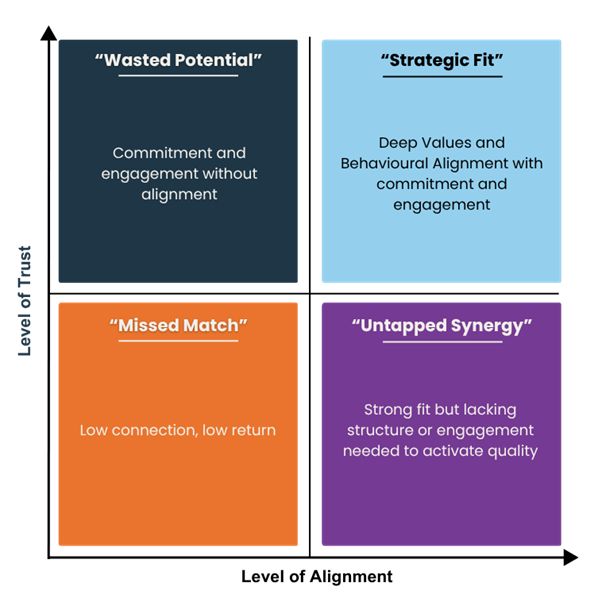Understanding how people connect and what they will build trust and alignment on with each other isn’t always easy or obvious – especially so if you’re in charge of making those connections.
So what lens do you look through?
The Match Quality Quadrant is one way to assess matches and professional relationships through the lens of trust and alignment. It can be applied within organisations from an individual level through to teams as a whole.

So how is it used?
It can help you identify if a mismatch or weak relationship is the result of a misalignment, or low levels of trust, and most importantly, focus the course corrections based on the root cause of the mismatch, not guesswork.
So what does each quadrant mean?
👎 Missed Match – Connections that lack both shared values and meaningful engagement. These pairings often result in disengagement, low rapport, and minimal development. “Low connection, low return”
👎 Untapped Synergy – Strong potential due to style and attribute alignment, but connection on deeper characteristics means the relationship under performs. With focused relationship development, these matches could thrive. “Strong fit but lacking structure of engagement needed to activate quality”
👎 Wasted Potential – Matches may spark initial energy through novelty or challenge, but without foundational alignment, they often struggle to last. “Commitment and engagement without alignment”
✅ Strategic Fit – The ideal zone. Matches are grounded in trust, shared values, complementary strengths, and mutual commitment – leading to high performance, growth, and retention. “Deep values and behavioural alignment with commitment and engagement”
Some recent research and trends.
▪️ 85% of organisations do not currently use trust-based matching to pair individuals together
▪️ 60% match on surface traits only
▪️ 25% match on attributes and styles (‘easy’ to see and guess)
▪️ 10% match on personality and values (much harder to do)
▪️ 5% match on deeper level characteristics (almost impossible unless there is a small, well known cohort)
When was the last time you noticed the levels of trust and alignment in your organisation? What was it telling you?
Get in touch to learn how having the right data can set your organisations relationships up for success.
